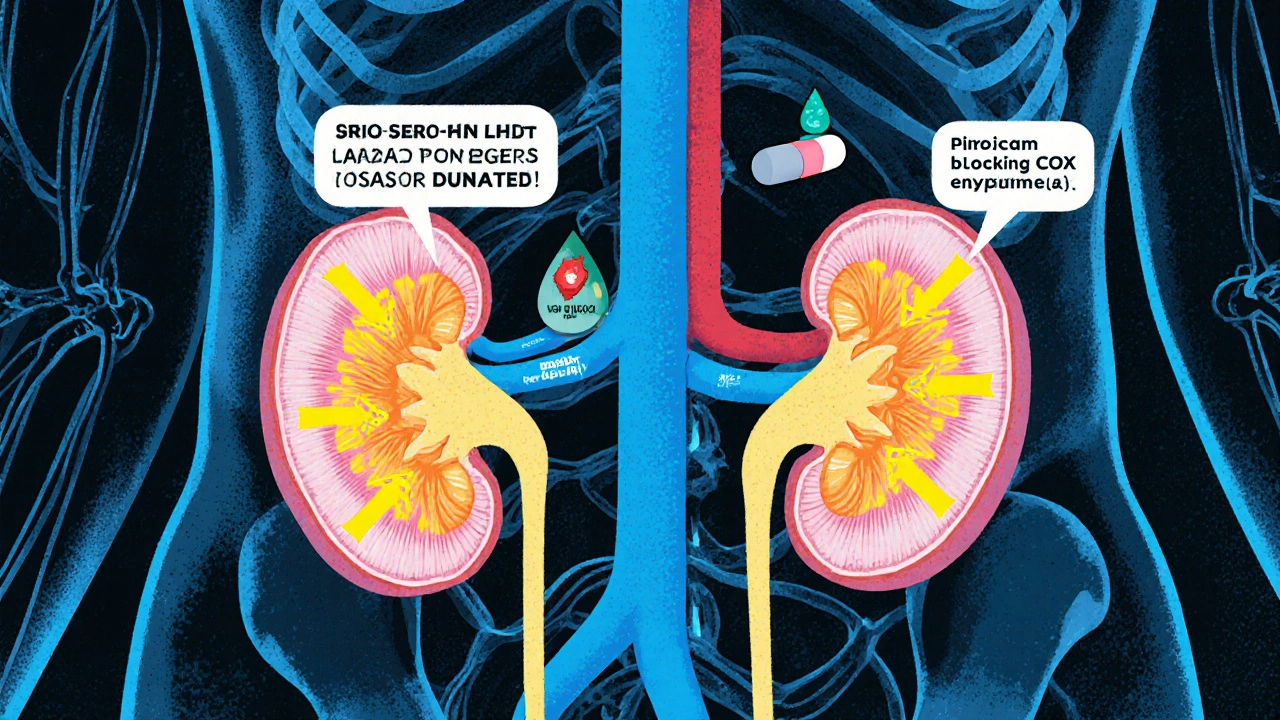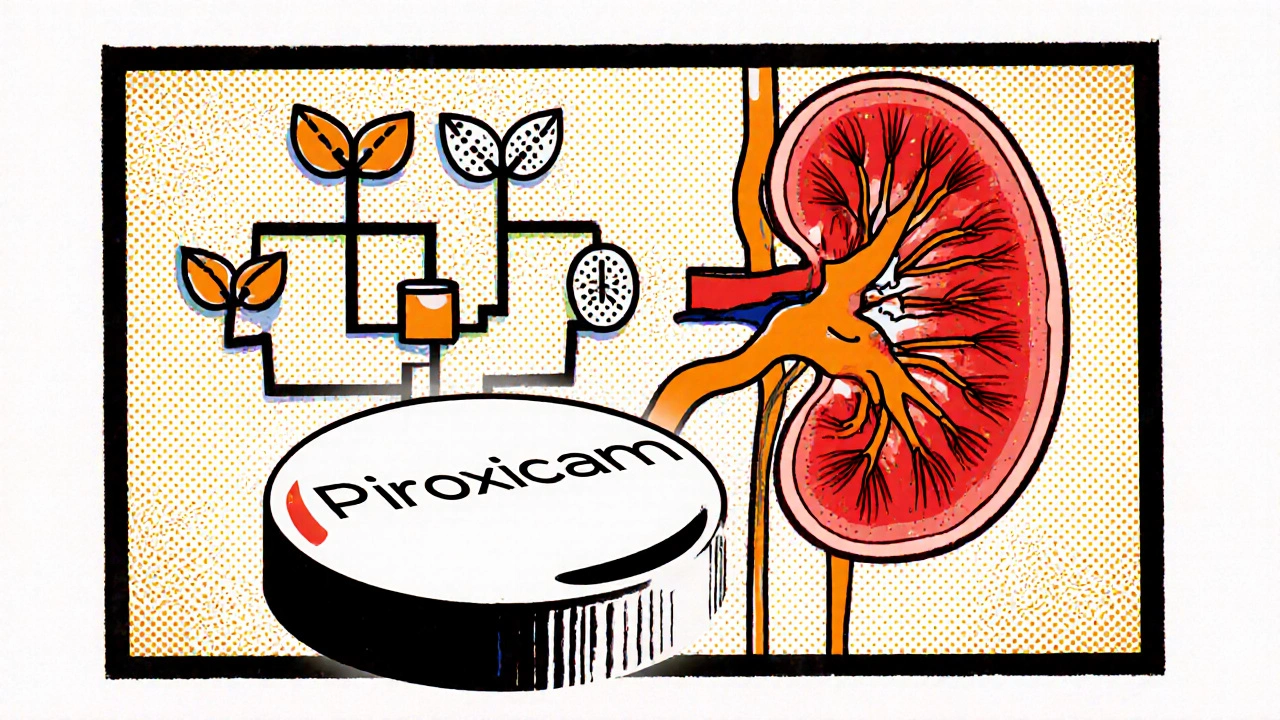Key Takeaways
- Piroxicam belongs to the NSAID class and can impair kidney function, especially in high‑risk patients.
- It reduces prostaglandin production by blocking cyclooxygenase, which limits the kidneys' ability to regulate blood flow.
- Acute kidney injury (AKI) and worsening chronic kidney disease (CKD) are the main concerns.
- Older adults, people with dehydration, and those on other nephrotoxic drugs need extra monitoring.
- Regular blood‑work, dose adjustments, and choosing COX‑2‑selective alternatives can lower the Piroxicam kidney risk.
What is Piroxicam?
When physicians write a prescription for Piroxicam is a non‑steroidal anti‑inflammatory drug (NSAID) commonly used to treat arthritis, musculoskeletal pain and postoperative inflammation, they are relying on a medication that has been on the market since the 1970s. Its long half‑life (about 50 hours) allows once‑daily dosing, which many patients find convenient.
How Piroxicam Works: The COX Connection
The drug’s pain‑relieving power comes from inhibiting Cyclooxygenase (COX‑1 and COX‑2 enzymes that convert arachidonic acid into prostaglandins). Prostaglandins not only trigger inflammation and pain, they also dilate blood vessels in the kidneys, helping maintain glomerular filtration when blood pressure drops.
By curbing prostaglandin synthesis, piroxicam reduces swelling but also removes a protective vasodilatory signal that the kidneys rely on during stress.
Kidney Basics: Why Blood Flow Matters
The kidneys filter roughly 180 liters of blood daily, extracting waste, balancing electrolytes and regulating fluid volume. A key metric doctors watch is the glomerular filtration rate (GFR), often estimated (eGFR) from serum creatinine and patient demographics. When renal blood flow falls, GFR drops, leading to accumulation of toxins and potential acute kidney injury.

Why NSAIDs Can Harm Kidneys
All NSAIDs are drugs that block COX enzymes, thereby decreasing prostaglandin production throughout the body. In the kidney, prostaglandins act like a backup pump, especially when the renin‑angiotensin system constricts the afferent arteriole. Removing that backup can tip the balance toward reduced perfusion.
Typical scenarios that expose the kidney to danger include dehydration, low blood pressure, heart failure or the use of ACE inhibitors that already narrow the afferent vessels.
Specific Kidney Risks Linked to Piroxicam
Evidence from pharmacovigilance databases and cohort studies shows three main patterns of kidney injury linked to piroxicam:
- Acute kidney injury (AKI): Sudden rise in serum creatinine often occurring within a week of starting therapy, especially after surgery or during an illness that causes fluid loss.
- Exacerbation of chronic kidney disease (CKD): In patients with baseline eGFR < 60 mL/min/1.73 m², long‑term use can accelerate the decline of renal function, sometimes by 4‑6 mL/min per year.
- Electrolyte disturbances: Sodium retention and potassium loss are reported, leading to hypertension or arrhythmias in vulnerable individuals.
One UK‑based study of 12,000 NSAID users found that piroxicam was associated with a 1.8‑fold higher odds of AKI compared with ibuprofen, after adjusting for age and comorbidities.
Who Is Most Vulnerable?
The following groups need extra caution:
- Elderly patients (typically over 65 years, whose renal reserve dwindles and who often take multiple medications)
- Anyone with pre‑existing Chronic kidney disease (stage 3 or worse, eGFR < 60 mL/min/1.73 m²)
- People who are dehydrated, have gastro‑intestinal losses, or are on diuretics
- Patients concurrently taking ACE inhibitors or angiotensin‑II receptor blockers, which already reduce renal perfusion
- Individuals using other nephrotoxic agents such as Ibuprofen or high‑dose aspirin
Safe Use Guidelines for Patients and Prescribers
If piroxicam is the best choice for pain control, follow these practical steps to protect the kidneys:
- Start with the lowest effective dose (usually 10 mg once daily) and avoid loading doses.
- Check baseline kidney function: measure serum creatinine, calculate eGFR, and note any proteinuria.
- Re‑check renal labs after 1-2 weeks, then every 3 months for chronic therapy.
- Stay well‑hydrated; advise patients to drink at least 1.5 L of fluid daily unless contraindicated.
- Consider Celecoxib (a COX‑2‑selective NSAID with a lower impact on renal prostaglandins) as an alternative for those with mild CKD.
- Avoid concomitant use of other NSAIDs, high‑dose aspirin, or nephrotoxic antibiotics (e.g., aminoglycosides).
- If eGFR falls below 30 mL/min/1.73 m², discontinue piroxicam and switch to non‑NSAID analgesics.
How Piroxicam Compares with Other NSAIDs on Kidney Safety
| Drug | COX Selectivity | Typical Dose | Reported AKI Odds Ratio vs. Non‑NSAID | Renal Monitoring Recommendation |
|---|---|---|---|---|
| Piroxicam | Non‑selective (COX‑1 > COX‑2) | 10‑20 mg daily | 1.8 | Baseline & 2‑week labs, then quarterly |
| Ibuprofen | Non‑selective (balanced) | 200‑400 mg q6‑8h | 1.3 | Baseline & 1‑month labs if > 3 months use |
| Celecoxib | COX‑2 selective | 100‑200 mg daily | 1.1 | Baseline only unless high‑risk |
The numbers above come from pooled analyses of UK primary‑care databases up to 2024. They illustrate why piroxicam sits at the higher end of the risk spectrum.
Practical Checklist for Clinicians
- Confirm indication - is piroxicam the most appropriate NSAID?
- Screen for CKD: eGFR < 60 → consider alternative.
- Review concurrent meds - remove overlapping NSAIDs.
- Educate patients about hydration and warning signs (reduced urine output, swelling, fatigue).
- Document baseline creatinine and schedule follow‑up labs.
- Adjust dose if eGFR 30‑59 mL/min/1.73 m² (reduce to 10 mg daily).
- Discontinue if creatinine rises > 30 % from baseline.
Frequently Asked Questions
Can I take piroxicam if I have mild kidney disease?
If your eGFR is between 45‑59 mL/min/1.73 m², a reduced dose (10 mg daily) may be acceptable, but you need baseline labs and close follow‑up. Many clinicians prefer a COX‑2‑selective NSAID instead.
What symptoms signal a kidney problem while on piroxicam?
Watch for sudden swelling in ankles or feet, decreased urine output, dark‑colored urine, persistent fatigue, or a rising blood pressure. Any of these should trigger immediate lab testing.
Is it safe to combine piroxicam with a diuretic?
Combining them raises the chance of dehydration‑related AKI. If the combination is unavoidable, increase fluid intake and monitor creatinine every 1-2 weeks.
How long does piroxicam stay in the body?
Its half‑life is roughly 50 hours, so steady‑state levels are reached after about 10 days. This long persistence can prolong any renal impact.
Are there any lab thresholds that dictate stopping piroxicam?
A rise in serum creatinine of more than 30 % from baseline, or an eGFR drop below 30 mL/min/1.73 m², should prompt immediate discontinuation and a switch to non‑NSAID analgesia.


Comments
ahmed ali
Alright, let me break down why the whole narrative about piroxicam being a silent killer is, in my opinion, an overblown myth that many clinicians love to repeat.
First off, the drug’s half‑life of roughly 50 hours does indeed mean it lingers, but that same property grants you the luxury of once‑daily dosing, which can actually improve adherence compared to more frequent NSAIDs.
Second, the cited 1.8‑fold increase in AKI risk versus ibuprofen is derived from observational databases that cannot fully adjust for confounding variables such as baseline dehydration or concurrent ACE‑inhibitor use.
Third, remember that prostaglandin inhibition is a double‑edged sword: you get less inflammation, but you also lose that renal vasodilatory backup, a trade‑off that exists for any non‑selective NSAID, not just piroxicam.
Fourth, the recommendation to switch automatically to celecoxib ignores the fact that COX‑2 selectivity can still produce significant renal effects, especially in patients with compromised autoregulation.
Fifth, the guideline to check labs after two weeks is sound, yet many practitioners already monitor renal function quarterly for all high‑risk meds, making the protocol redundant.
Sixth, dehydration is the real villain here; if you keep patients well‑hydrated, the incremental risk imposed by piroxicam shrinks dramatically.
Seventh, the article fails to mention that low‑dose aspirin, often taken concurrently, may actually blunt the renal impact by its antiplatelet properties, a nuance worth noting.
Eighth, the notion that a rise of 30 % in serum creatinine mandates immediate cessation is a bit draconian; a step‑wise dose reduction can rescue both pain control and renal function.
Ninth, you’ll find that in large registry studies, the absolute number of AKI events attributable solely to piroxicam is minuscule compared with the total population of NSAID users.
Tenth, the emphasis on eGFR thresholds below 30 mL/min/1.73 m² is appropriate, but the same threshold applies to ibuprofen, naproxen, and diclofenac, so singling out piroxicam feels selective.
Eleventh, many patients on piroxicam are also on diuretics, and that combination is indeed riskier, but the article doesn’t advise dose tweaking of the diuretic, which would be a smarter move.
Twelfth, let’s not forget that chronic pain itself can lead to sympathetic overdrive, which worsens renal perfusion independent of any NSAID effect.
Thirteenth, a practical tip: stagger the timing of piroxicam and any ACE‑inhibitor by a few hours to allow the kidney a brief window of prostaglandin‑mediated flow.
Fourteenth, for patients truly intolerant to NSAIDs, acetaminophen remains a safe alternative, something the piece completely omits.
Finally, while vigilance is key, branding piroxicam as the ‘bad guy’ without balanced context just fuels unnecessary fear among both prescribers and patients.
October 26, 2025 AT 21:39
Deanna Williamson
The data you quoted lacks context and oversimplifies the renal risks.
November 2, 2025 AT 20:19
Joe Langner
Hey folks, good that we’re digging into the nitty‑gritty of piroxicam and kidneys!
Even though the stats look scary at first glance, remember that many patients do just fine when they stay hydrated and get regular check‑ups.
It’s kinda like sailing – you watch the weather, adjust the sails, and you’ll reach the shore safely.
If you pair the drug with a low‑dose ACE‑inhibitor, just keep an eye on the labs and you’ll probably avoid that dreaded creatinine jump.
Also, switching to a COX‑2‑selective option can be a gentle compromise for those who are a bit jittery about kidney function.
Bottom line, with a bit of mindfulness and teamwork between doc and patient, piroxicam can still have a place in the pain‑management toolbox.
November 9, 2025 AT 18:59
Katherine Brown
One must acknowledge that the article provides a thorough overview of the pharmacodynamics of piroxicam. Nevertheless, the recommendation to monitor renal parameters at a two‑week interval may not be universally applicable, particularly in patients with stable chronic kidney disease. Consequently, clinicians should individualize follow‑up schedules based on the patient’s baseline renal reserve and concomitant therapies.
November 16, 2025 AT 17:39
Ben Durham
From a clinical perspective, the emphasis on hydration cannot be overstated; adequate fluid intake mitigates the vasoconstrictive effect of prostaglandin inhibition.
Moreover, the suggestion to consider celecoxib as an alternative aligns with current evidence favouring COX‑2 selectivity in mild CKD.
It is also prudent to review all concomitant nephrotoxic agents before initiating piroxicam.
In practice, a simple checklist can streamline this process and enhance patient safety.
November 23, 2025 AT 16:19
Tony Stolfa
Honestly, the article reads like a scare‑tactic brochure crafted by someone who fears any NSAID that isn’t ibuprofen.
It pretends that piroxicam is a unique monster, while conveniently ignoring that naproxen and diclofenac share the same renal profile.
If you’re looking for nuance, you won’t find it here-just a laundry list of bullet points designed to frighten.
Real pharmacologists know that dose, duration, and patient comorbidities matter far more than the brand name.
So spare us the melodrama and focus on evidence‑based prescribing.
November 30, 2025 AT 14:59
Holly Kress
I appreciate the thoroughness of the piece, but it could benefit from a clearer algorithm for dose adjustment when eGFR falls between 30 and 60.
Additionally, highlighting patient education on early warning signs would empower individuals to seek timely care.
Overall, the checklist is a solid foundation for safe piroxicam use.
December 7, 2025 AT 13:39